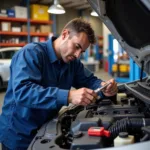Rust on a car is more than just an eyesore; it’s a sign of corrosion that can compromise the structural integrity of your vehicle. Addressing rust promptly is crucial to prevent further damage and maintain the value of your car. This guide provides a comprehensive overview of How To Repair Rust On A Car, from identifying the problem to implementing effective solutions.
Repairing rust on a car involves several steps, each requiring specific tools and techniques. The extent of the rust will determine the complexity of the repair. Surface rust can often be treated with sandpaper and rust converter, while more severe rust might require patching or replacing entire panels. It’s important to correctly assess the damage to choose the most appropriate repair method. For more complicated repairs, seeking professional assistance is recommended. You can learn more about how car problems are professionally diagnosed at what do you call who repairs bikes or car.
Identifying the Type and Extent of Rust
Before embarking on any rust repair, it’s vital to understand the different types of rust and how far the corrosion has spread. Surface rust appears as small, discolored spots and affects only the top layer of paint. Scale rust, on the other hand, penetrates deeper and appears as flaky, bubbled paint. Penetrating rust is the most severe, eating through the metal and creating holes.
Determining the Best Repair Method for Your Car’s Rust
The appropriate repair method depends on the type and severity of the rust. Surface rust can often be addressed with sandpaper and a rust converter. More significant rust damage may necessitate patching or replacing affected panels.
DIY Rust Repair: A Step-by-Step Guide
For minor rust issues, a DIY approach can be effective. Here’s a step-by-step guide:
- Clean the Area: Thoroughly clean the rusted area with soap and water, then dry it completely.
- Remove the Rust: Use sandpaper, a wire brush, or a sanding disc to remove all traces of rust. Be sure to wear safety glasses and a dust mask.
- Apply Rust Converter: Apply a rust converter to the affected area. This chemically converts the rust into a stable compound.
- Prime and Paint: Once the converter dries, prime the area and then apply matching automotive paint.
For information on addressing rust in more difficult-to-reach areas, check out this article: how to repair rust underneath car.
When to Call a Professional
While minor rust repairs can be handled at home, more extensive damage requires professional attention. A professional auto body shop has the expertise and specialized equipment to address complex rust issues effectively.
Understanding the Costs of Professional Rust Repair
The cost of professional rust repair can vary depending on the extent of the damage and the type of vehicle. Factors influencing the price include the size of the rusted area, the need for panel replacement, and the labor costs.
 Professional Rust Repair Process on a Car
Professional Rust Repair Process on a Car
Preventing Rust: Protecting Your Investment
Preventing rust is the best way to protect your car’s value and longevity. Regularly washing and waxing your car can help prevent rust formation. Applying a rust inhibitor to vulnerable areas can also provide added protection. Learn more about fixing car issues at can car steering lock can be repair.
Simple Steps for Effective Rust Prevention
- Regular Washing: Wash your car regularly, especially during winter months when road salt can accelerate rust formation.
- Waxing: Apply a coat of wax every few months to create a protective barrier against the elements.
- Rust Inhibitor: Use a rust inhibitor on undercarriage and other vulnerable areas.
“Regular maintenance is key to preventing rust,” says John Miller, Certified Automotive Technician. “A little preventative care can save you a lot of money and hassle down the road.”
Conclusion
Knowing how to repair rust on a car is crucial for any car owner. By addressing rust promptly and taking preventative measures, you can maintain the structural integrity and value of your vehicle. Whether you tackle minor repairs yourself or seek professional assistance, remember that proactive rust management is an essential aspect of car ownership. For more information on car rust repair, see if rust repair is even possible: can you repair rust on a car. Don’t let rust diminish your car’s lifespan – take action today!
“Ignoring rust is like ignoring a cavity,” adds Sarah Johnson, Automotive Engineer. “It will only get worse and more expensive to fix over time.”
 Rust Prevention Techniques for Cars
Rust Prevention Techniques for Cars
FAQ
- What causes rust on a car? Rust occurs when iron reacts with oxygen and water, leading to corrosion.
- Can I repair rust myself? Minor surface rust can be repaired with DIY methods. More severe rust requires professional attention.
- How much does professional rust repair cost? The cost varies depending on the extent of the damage.
- What is the best way to prevent rust? Regularly washing, waxing, and applying rust inhibitor are effective preventative measures.
- Is it necessary to repair rust immediately? Yes, rust will spread and worsen if left untreated, compromising the structural integrity of the car.
- What tools do I need for DIY rust repair? Sandpaper, wire brush, rust converter, primer, and paint are essential.
- How long does rust repair take? The duration depends on the severity of the rust and the chosen repair method.
If you’re facing issues with peeling leather car seats, you can also find information on how to address that problem: how to repair peeling leather car seat. Need help? Contact us via WhatsApp: +1(641)206-8880 or Email: [email protected]. Our customer service team is available 24/7.


